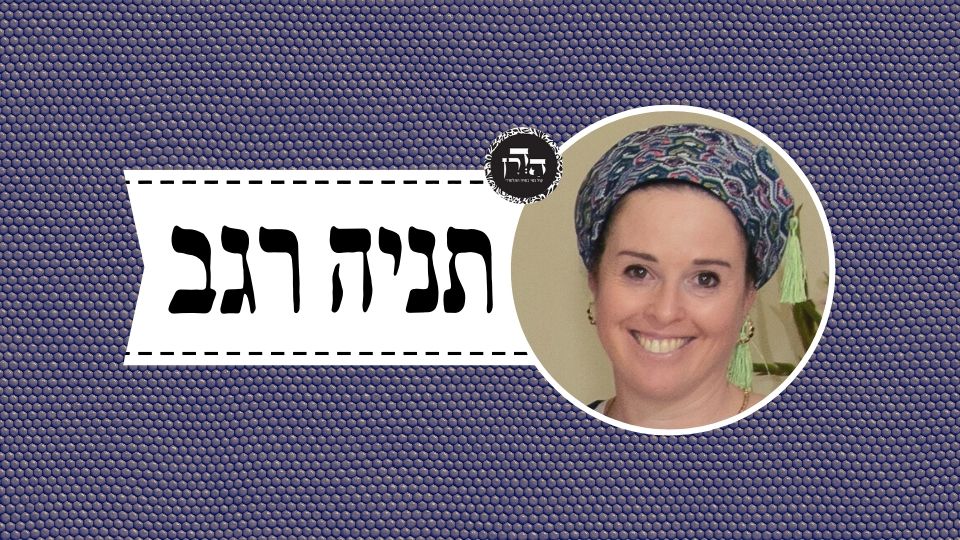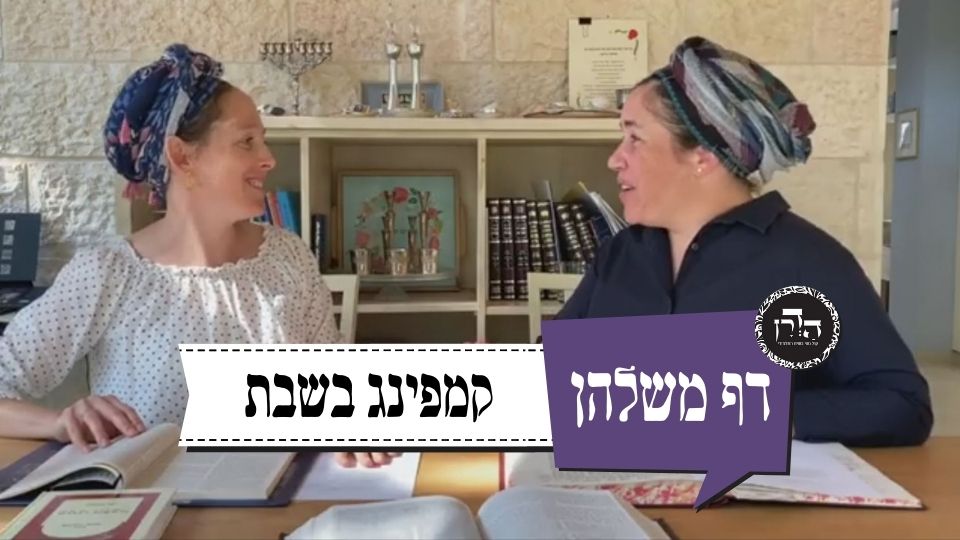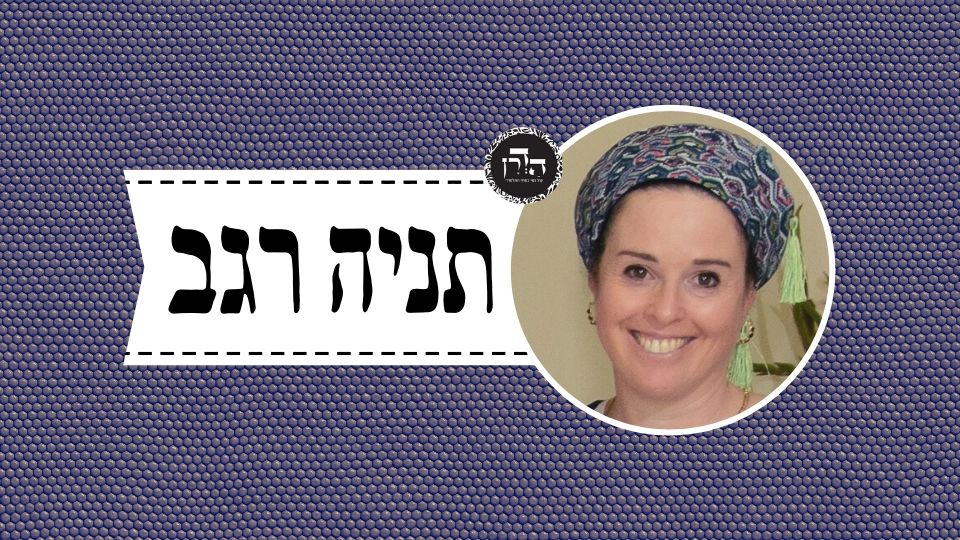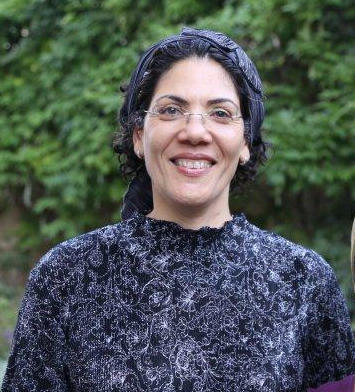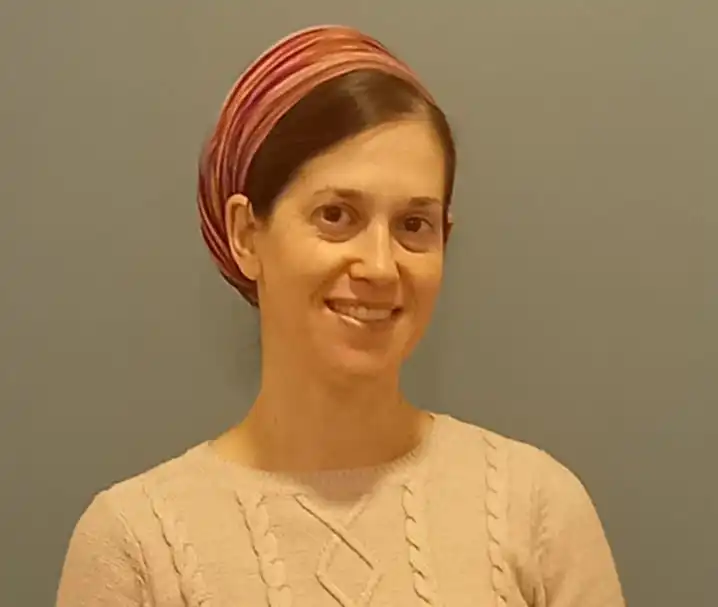עירובין יא
אִיפְּכָא מַאי?
The Gemara asks: What is the halakha in the opposite situation? Does an opening in the form of a doorway also serve to permit carrying in an alleyway that is more than twenty cubits high?
תָּא שְׁמַע דְּתַנְיָא: מָבוֹי שֶׁהוּא גָּבוֹהַּ מֵעֶשְׂרִים אַמָּה יְמַעֵט, וְאִם יֵשׁ לוֹ צוּרַת הַפֶּתַח אֵינוֹ צָרִיךְ לְמַעֵט.
The Gemara answers: Come and hear the answer to this question, as it was taught in a baraita: If the cross beam placed over the entrance to an alleyway is higher than twenty cubits, one must diminish its height, but if the entrance has an opening in the form of a doorway, he need not diminish it.
אֲמַלְתְּרָא בְּרׇחְבּוֹ מַאי? תָּא שְׁמַע, דְּתַנְיָא: מָבוֹי שֶׁהוּא גָּבוֹהַּ מֵעֶשְׂרִים אַמָּה יְמַעֵט, וְהָרָחָב מֵעֶשֶׂר יְמַעֵט, וְאִם יֵשׁ לוֹ צוּרַת הַפֶּתַח אֵינוֹ צָרִיךְ לְמַעֵט, וְאִם יֵשׁ לוֹ אֲמַלְתְּרָא אֵינוֹ צָרִיךְ לְמַעֵט.
The Gemara asks: What is the effect of a cornice with regard to the need to diminish the alleyway’s width? Does the cornice render the alleyway fit for one to carry within it, even if the entrance is more than ten cubits wide? The Gemara answers: Come and hear an answer as it was taught in a baraita: If the cross beam placed over the entrance to an alleyway is higher than twenty cubits, one must diminish its height, and if the alleyway is wider than ten cubits, one must diminish its width. However, if the entrance to the alleyway has an opening in the form of a doorway, he need not diminish it, and, similarly, if it has a cornice, he need not diminish it.
מַאי לָאו אַסֵּיפָא: לָא, אַרֵישָׁא.
The Gemara explains the proof it wishes to adduce from this baraita: What, is this statement with regard to the cornice not referring to the latter clause, i.e., the case of an alleyway that is wider than ten cubits, proving that a cornice can render an alleyway otherwise too wide fit for one to carry within it? The Gemara refutes this argument: No, this statement is referring to the first clause of the baraita, that a cornice is effective for an alleyway more than twenty cubits high, but it tells us nothing about one that is more than ten cubits wide.
מַתְנֵי לֵיהּ רַב יְהוּדָה לְחִיָּיא בַּר רַב קַמֵּיהּ דְּרַב: אֵינוֹ צָרִיךְ לְמַעֵט. אֲמַר לֵיהּ: אַתְנְיֵיהּ, צָרִיךְ לְמַעֵט.
With regard to the same issue, Rav Yehuda would teach the baraita to Ḥiyya bar Rav before Rav as follows: If the entrance to an alleyway that is wider than ten cubits has an opening in the form of a doorway, he need not diminish its width. Rav said to him: Teach him that the correct version of the baraita is: He must diminish its width.
אָמַר רַב יוֹסֵף: מִדִּבְרֵי רַבֵּינוּ נִלְמַד: חָצֵר שֶׁרוּבָּהּ פְּתָחִים וְחַלּוֹנוֹת — אֵינָהּ נִיתֶּרֶת בְּצוּרַת הַפֶּתַח.
Rav Yosef said: From the statement of our teacher, Rav, who said that the entrance to an alleyway must be diminished even if it has an opening in the form of a doorway, we will learn that with regard to a courtyard, the walls of which are mostly entrances and windows, it is not permitted to carry within it even by having an opening in the form of a doorway. Even if the entrances have an opening in the form of a doorway, this does not render a mostly breached courtyard wall into a closed wall.
מַאי טַעְמָא — הוֹאִיל וְיוֹתֵר מֵעֶשֶׂר אוֹסֵר בְּמָבוֹי, וּפָרוּץ מְרוּבֶּה עַל הָעוֹמֵד אוֹסֵר בֶּחָצֵר. מָה יוֹתֵר מֵעֶשֶׂר הָאוֹסֵר בְּמָבוֹי — אֵינוֹ נִיתָּר בְּצוּרַת הַפֶּתַח, אַף פָּרוּץ מְרוּבֶּה עַל הָעוֹמֵד הָאוֹסֵר בֶּחָצֵר — אֵינוֹ נִיתָּר בְּצוּרַת הַפֶּתַח.
What is the reason? Since an opening of more than ten cubits renders it prohibited for one to carry in an alleyway, and likewise when the breached segment of a wall that is greater than its standing segment renders it prohibited for one to carry in a courtyard, the following claim can be made: Just as, according to Rav, in the case of an opening more than ten cubits wide that renders it prohibited for one to carry in an alleyway, carrying in the alleyway is not permitted by the form of a doorway in the opening, so too a case where breached segment of a wall is greater than its standing segment that renders it prohibited for one to carry in a courtyard, carrying in the courtyard is not permitted by the form of a doorway in the opening.
מָה לְיוֹתֵר מֵעֶשֶׂר הָאוֹסֵר בְּמָבוֹי — שֶׁכֵּן לֹא הִתַּרְתָּ בּוֹ אֵצֶל פַּסֵּי בִירָאוֹת לְרַבִּי מֵאִיר, תֹּאמַר בְּפָרוּץ מְרוּבֶּה עַל הָעוֹמֵד הָאוֹסֵר בֶּחָצֵר — שֶׁכֵּן הִתַּרְתָּ אֵצֶל פַּסֵּי בִירָאוֹת לְדִבְרֵי הַכֹּל.
The Gemara rejects this argument: What is the basis for comparison to an opening that is more than ten cubits wide that renders it prohibited for one to carry in an alleyway? It is not permitted by having an opening in the form of a doorway because you did not permit an opening of that size with regard to the case of upright boards surrounding a well, in accordance with the opinion of Rabbi Meir. Can you say the same in a case where the breached segment of a wall is greater than the standing segment that renders it prohibited for one to carry in a courtyard, that carrying in the courtyard will not be permitted by the form of a doorway? That situation is clearly not as severe a problem, as you permitted carrying with regard to upright boards surrounding a well according to everyone. Consequently, no comparison can be made between the case of an opening wider than ten cubits in an alleyway and a partition in which the breached segment is greater than the standing segment in a courtyard.
לֵימָא מְסַיַּיע לֵיהּ: דְּפָנוֹת הַלָּלוּ שֶׁרוּבָּן פְּתָחִים וְחַלּוֹנוֹת מוּתָּר, וּבִלְבַד שֶׁיְּהֵא עוֹמֵד מְרוּבֶּה עַל הַפָּרוּץ.
The Gemara suggests: Let us say that the following baraita supports this opinion that the form of a doorway is ineffective in a case where the breached segments of a wall are greater than its standing segments: With regard to the area enclosed by these walls that most of them consist of entrances and windows, it is permitted to carry on Shabbat therein, provided that the standing segments are greater than the breached segments.
שֶׁרוּבָּן סָלְקָא דַּעְתָּךְ? — אֶלָּא אֵימָא: שֶׁרִיבָּה בָּהֶן פְּתָחִים וְחַלּוֹנוֹת, וּבִלְבַד שֶׁיְּהֵא עוֹמֵד מְרוּבֶּה עַל הַפָּרוּץ.
The Gemara first analyzes the wording of the baraita: The Gemara analyzes the formulation of the baraita: Can it enter your mind that the baraita is referring to a case where most of the walls are entrances and windows? If so, the standing segments are not greater than the breached segments. Rather, emend the baraita: Carrying in the area enclosed by these walls to which he added many entrances and windows is permitted, provided that the standing segments are greater than the breached segments. Apparently, if the breached segments are greater than the standing segments, carrying is not permitted even if the breaches are in the form of doorways.
אָמַר רַב כָּהֲנָא: כִּי תַּנְיָא הָהִיא — בְּפִיתְחֵי שִׁימָאֵי.
Rav Kahana said that his is not an absolute proof: When this baraita was taught, it was taught with regard to broken entrances [pitḥei shima’ei] that lack the proper form of doorways.
מַאי פִּיתְחֵי שִׁימָאֵי? פְּלִיגִי בַּהּ רַב רְחוּמִי וְרַב יוֹסֵף. חַד אָמַר: דְּלֵית לְהוּ שִׁקְפֵי, וְחַד אָמַר: דְּלֵית לְהוּ תִּיקְרָה.
The Gemara asks: What are broken entrances? Rav Reḥumei and Rav Yosef disagreed on the matter. One said that they do not have proper doorposts, and the other one said that they do not have lintels above the openings.
וְאַף רַבִּי יוֹחָנָן סָבַר לַהּ לְהָא דְּרַב. דְּאָמַר רָבִין בַּר רַב אַדָּא אָמַר רַבִּי יִצְחָק: מַעֲשֶׂה בְּאָדָם אֶחָד מִבִּקְעַת בֵּית חוֹרְתָן שֶׁנָּעַץ אַרְבָּעָה קוּנְדֵּיסִין בְּאַרְבַּע פִּינּוֹת הַשָּׂדֶה, וּמָתַח זְמוֹרָה עֲלֵיהֶם. וּבָא מַעֲשֶׂה לִפְנֵי חֲכָמִים, וְהִתִּירוּ לוֹ לְעִנְיַן כִּלְאַיִם.
The Gemara comments: And even Rabbi Yoḥanan holds that opinion of Rav, that an opening in the form of a doorway does not permit carrying if the opening is more than ten cubits wide. As Ravin bar Rav Adda said that Rabbi Yitzḥak said: There was an incident involving a person from the valley of Beit Ḥortan who stuck four poles [kunddeisin] into the ground in the four corners of his field, and stretched a vine over them, creating the form of a doorway on each side. He intended to seal the area so that he would be permitted to plant a vineyard in close proximity without creating a forbidden mixture of diverse kinds in a vineyard. And the case came before the Sages, and they permitted him to consider it sealed with regard to diverse kinds.
וְאָמַר רֵישׁ לָקִישׁ: כְּדֶרֶךְ שֶׁהִתִּירוּ לוֹ לְעִנְיַן כִּלְאַיִם כָּךְ הִתִּירוּ לוֹ לְעִנְיַן שַׁבָּת. רַבִּי יוֹחָנָן אָמַר: לְכִלְאַיִם הִתִּירוּ לוֹ, לְעִנְיַן שַׁבָּת לֹא הִתִּירוּ לוֹ.
And Reish Lakish said: Just as they permitted him to consider it sealed with regard to diverse kinds, so too they permitted him to consider it sealed with regard to Shabbat, i.e., they permitted carrying within this area. Rabbi Yoḥanan said: With regard to diverse kinds, they permitted him to consider it sealed, however, with regard to Shabbat, they did not permit him to do so.
בְּמַאי עָסְקִינַן? אִילֵימָא מִן הַצַּד, וְהָאָמַר רַב חִסְדָּא: צוּרַת הַפֶּתַח שֶׁעֲשָׂאָהּ מִן הַצַּד לֹא עָשָׂה וְלֹא כְלוּם.
The Gemara clarifies: With what case are we dealing here? If you say that he draped the vines on the posts from the side, rather than on top of them, didn’t Rav Ḥisda say with regard to Shabbat: If one constructed an opening in the form of a doorway from the side, he has done nothing?
אֶלָּא עַל גַּבָּן. וּבְמַאי? אִילֵימָא בְּעֶשֶׂר — בְּהָא לֵימָא רַבִּי יוֹחָנָן בְּשַׁבָּת לָא?!
Rather, it must be that he set the vines on top of the posts. And in what circumstances did Rabbi Yoḥanan and Reish Lakish disagree? If you say that the posts were set at a distance of ten cubits from each other, would Rabbi Yoḥanan say in that case that with regard to Shabbat, they did not permit him to consider the area sealed? Everyone agrees that the form of a doorway is effective for an entrance that is only ten cubits wide.
אֶלָּא לָאו — בְּיָתֵר מֵעֶשֶׂר.
Rather, isn’t it referring to a case where the posts were more than ten cubits apart? Apparently, Rabbi Yoḥanan agrees with Rav, that an opening in the form of a doorway does not permit carrying if the original opening is wider than ten cubits.
לָא, לְעוֹלָם בְּעֶשֶׂר וּמִן הַצַּד — וּבִדְרַב חִסְדָּא קָא מִיפַּלְגִי.
The Gemara refutes this proof: No, actually it is referring to a case where the posts were ten cubits apart, and the person attached the vines to the posts from the side. And Reish Lakish and Rabbi Yoḥanan disagree with regard to the opinion of Rav Ḥisda. Reish Lakish maintains that the form of a doorway is effective even when the horizontal cross beam is attached to the vertical posts from the side, and Rabbi Yoḥanan agrees with Rav Ḥisda that a form of a doorway is ineffective for the purpose of carrying on Shabbat when constructed in such a manner.
וּרְמִי דְּרַבִּי יוֹחָנָן אַדְּרַבִּי יוֹחָנָן, וּרְמִי דְּרֵישׁ לָקִישׁ אַדְּרֵישׁ לָקִישׁ, דְּאָמַר רֵישׁ לָקִישׁ מִשּׁוּם רַבִּי יְהוּדָה בְּרַבִּי חֲנִינָא:
The Gemara comments: But it is possible to raise a contradiction between this statement of Rabbi Yoḥanan and another statement of Rabbi Yoḥanan; and it is possible to raise a contradiction between this statement of Reish Lakish and another statement of Reish Lakish. As Reish Lakish said in the name of Rabbi Yehuda, son of Rabbi Ḥanina:
פֵּיאָה מוּתֶּרֶת לְעִנְיַן כִּלְאַיִם, אֲבָל לֹא לְשַׁבָּת. וְרַבִּי יוֹחָנָן אָמַר: כִּמְחִיצּוֹת לְשַׁבָּת דְּלָא, כָּךְ מְחִיצּוֹת לְכִלְאַיִם דְּלֹא.
A braid of vines plaited around poles to form a partition is permitted with regard to diverse kinds, i.e., it is considered a partition that renders planting grapevines in close proximity to other crops permitted, but not with regard to Shabbat. And Rabbi Yoḥanan said: Just as such a braid is not considered a partition with regard to Shabbat, so too it is not considered a partition with regard to diverse kinds. Their opinions in the dispute here apparently contradict their opinions in the dispute cited above.
בִּשְׁלָמָא דְּרֵישׁ לָקִישׁ אַדְּרֵישׁ לָקִישׁ לָא קַשְׁיָא: הָא — דִידֵיהּ, הָא — דְרַבֵּיהּ. אֶלָּא דְּרַבִּי יוֹחָנָן אַדְּרַבִּי יוֹחָנָן קַשְׁיָא!
Granted, the apparent contradiction between one statement of Reish Lakish and the other statement of Reish Lakish poses no difficulty, as this statement, according to which such a braid of vines is an effective partition even with regard to Shabbat, reflects his own opinion; that statement, according to which it is an effective partition only with regard to diverse kinds, reflects the opinion of his teacher, Rabbi Yehuda, son of Rabbi Ḥanina. However, the apparent contradiction between one statement of Rabbi Yoḥanan and the other statement of Rabbi Yoḥanan, poses a difficulty.
אִי אָמְרַתְּ בִּשְׁלָמָא: הָתָם — עַל גַּבָּן, הָכָא — מִן הַצַּד, שַׁפִּיר. אֶלָּא אִי אָמְרַתְּ: אִידֵּי וְאִידֵּי מִן הַצַּד, מַאי אִיכָּא לְמֵימַר?
Granted, if you say that there, where Rabbi Yoḥanan ruled that a braid of vines is an effective partition with regard to diverse kinds, it is referring to a case where the vines were placed on top of the posts, while here, where he rules that it is ineffective even with regard to diverse kinds, it is referring to a case where they were attached to the posts from the side, it works out well. However, if you say that both this and that are cases where the vines were attached from the side, what is there to say?
לְעוֹלָם, אִידֵּי וְאִידֵּי מִן הַצַּד: הָתָם — בְּעֶשֶׂר, הָכָא — בְּיוֹתֵר מֵעֶשֶׂר.
The Gemara answers: Actually, both this and that are cases where the vines were attached to the side posts from the side. There, where Rabbi Yoḥanan ruled that the braid is an effective partition with regard to diverse kinds, it is referring to a case where the poles were only ten cubits apart; here, where he rules that it is ineffective even with regard to diverse kinds, it is referring to a case where the poles were more than ten cubits apart.
וּמְנָא תֵּימְרָא דְּשָׁנֵי לַן בֵּין עֶשֶׂר לְיוֹתֵר מֵעֶשֶׂר — דַּאֲמַר לֵיהּ רַבִּי יוֹחָנָן לְרֵישׁ לָקִישׁ: לֹא כָּךְ הָיָה הַמַּעֲשֶׂה, שֶׁהָלַךְ רַבִּי יְהוֹשֻׁעַ אֵצֶל רַבִּי יוֹחָנָן בֶּן נוּרִי לִלְמוֹד תּוֹרָה, אַף עַל פִּי שֶׁבָּקִי בְּהִלְכוֹת כִּלְאַיִם, וּמְצָאוֹ שֶׁיּוֹשֵׁב בֵּין הָאִילָנוֹת וּמָתַח זְמוֹרָה מֵאִילָן לְאִילָן. וְאָמַר לוֹ: רַבִּי, אִי גְּפָנִים כָּאן מַהוּ לִזְרוֹעַ כָּאן? אָמַר לוֹ: בְּעֶשֶׂר מוּתָּר, בְּיוֹתֵר מֵעֶשֶׂר אָסוּר.
And from where do you say that we distinguish between an opening of ten cubits and an opening of more than ten cubits? As Rabbi Yoḥanan said to Reish Lakish: That is not the way that the incident transpired. As Rabbi Yehoshua went to Rabbi Yoḥanan ben Nuri to study Torah, even though Rabbi Yehoshua himself was an expert in the halakhot of diverse kinds and found him sitting among the trees, and Rabbi Yehoshua stretched a vine from one tree to another and said to him: Rabbi, if there are grapevines here, in the enclosed area, what is the halakha with regard to sowing diverse kinds of seeds here, on the other side of the partition? Rabbi Yoḥanan ben Nuri said to him: In a case where the trees are only ten cubits apart, it is permitted; however, where they are more than ten cubits apart, it is prohibited.
בְּמַאי עָסְקִינַן? אִילֵימָא עַל גַּבָּן יוֹתֵר מֵעֶשֶׂר אָסוּר — וְהָתַנְיָא: הָיוּ שָׁם קָנִין הַדּוֹקְרָנִין וְעָשָׂה לָהֶן פֵּיאָה מִלְמַעְלָה, אֲפִילּוּ בְּיוֹתֵר מֵעֶשֶׂר מוּתָּר!
The Gemara clarifies the case: With what are we dealing here? If you say that the vines were placed on top of the trees, when they are more than ten cubits apart is it prohibited? But wasn’t it taught in a baraita with regard to diverse kinds: If there were forked reeds there and he plaited a braid of vines above them, then even if the reeds were set more than ten cubits apart, it is permitted? With regard to diverse kinds, the form of a doorway when properly constructed is certainly effective.
אֶלָּא לָאו מִן הַצַּד, וְקָאֲמַר לֵיהּ בְּעֶשֶׂר מוּתָּר, יוֹתֵר מֵעֶשֶׂר אָסוּר. שְׁמַע מִינַּהּ.
Rather, is it not referring to a case where he attached the vines to the trees from the side, and he is saying to him: In a case where the trees are only ten cubits apart, it is permitted; however, in a case where the trees are more than ten cubits apart, it is prohibited? The Gemara concludes: Indeed, learn from it that there is a distinction between poles that are ten cubits apart and poles that are more than ten cubits apart, and that this distinction resolves the contradiction between the two statements of Rabbi Yoḥanan.
גּוּפָא, אָמַר רַב חִסְדָּא: צוּרַת הַפֶּתַח שֶׁעֲשָׂאָהּ מִן הַצַּד — לֹא עָשָׂה וְלֹא כְלוּם.
The Gemara now examines the matter itself with regard to Rav Ḥisda’s statement cited above. Rav Ḥisda said: If one prepared an opening in the form of a doorway from the side, placing the horizontal cross beam to the sides, rather than on top, of the vertical posts, he has not done anything.
וְאָמַר רַב חִסְדָּא: צוּרַת הַפֶּתַח שֶׁאָמְרוּ, צְרִיכָה שֶׁתְּהֵא בְּרִיאָה כְּדֵי לְהַעֲמִיד בָּהּ דֶּלֶת, וַאֲפִילּוּ דֶּלֶת שֶׁל קַשִּׁין.
And Rav Ḥisda also said: The opening in the form of a doorway of which the Sages spoke must be strong enough to mount a door in it, and even if it is merely a flimsy door of straw.
אָמַר רֵישׁ לָקִישׁ מִשּׁוּם רַבִּי יַנַּאי: צוּרַת הַפֶּתַח צְרִיכָה הֶיכֵּר צִיר. מַאי הֶיכֵּר צִיר? אָמַר רַב אַוְיָא: אַבְקָתָא.
Reish Lakish said in the name of Rabbi Yannai: The opening in the form of a doorway requires a mark in the doorpost for hinges. The Gemara asks: What is a mark for hinges? Rav Avya said: Loops [avkata] into which the hinge is inserted, so that it will be possible to mount a door in the doorway.
אַשְׁכְּחִינְהוּ רַב אַחָא בְּרֵיהּ דְּרַב אַוְיָא לְתַלְמִידֵי דְּרַב אָשֵׁי, אֲמַר לְהוּ: אֲמַר מָר מִידֵּי בְּצוּרַת הַפֶּתַח? אֲמַרוּ לֵיהּ: לֹא אָמַר וְלֹא כְּלוּם.
The Gemara relates that Rav Aḥa, the son of Rav Avya, once found the students of Rav Ashi and said to them: Did the Master, Rav Ashi, say anything with regard to an opening in the form of a doorway? They said to him: He said nothing, implying that an indication for hinges is unnecessary.
תָּנָא: צוּרַת הַפֶּתַח שֶׁאָמְרוּ, קָנֶה מִכָּאן וְקָנֶה מִכָּאן וְקָנֶה עַל גַּבֵּיהֶן. צְרִיכִין לִיגַּע, אוֹ אֵין צְרִיכִין לִיגַּע? רַב נַחְמָן אָמַר: אֵין צְרִיכִין לִיגַּע. וְרַב שֵׁשֶׁת אָמַר: צְרִיכִין לִיגַּע.
A Sage taught a baraita: The form of a doorway of which they spoke consists of a reed from here, on one side, and a reed from there, on the opposite side, and a reed on top of them. The Gemara asks: Need the lower reeds reach high enough to touch the upper reed, or do they not need to touch it? Rav Naḥman said: They do not need to touch it; and Rav Sheshet said: They need to touch it.
אֲזַל רַב נַחְמָן וַעֲבַד עוֹבָדָא בֵּי רֵישׁ גָּלוּתָא כִּשְׁמַעְתֵּיהּ. אֲמַר לֵיהּ רַב שֵׁשֶׁת לְשַׁמָּעֵיהּ רַב גַּדָּא: זִיל, שְׁלוֹף שְׁדִינְהוּ. אֲזַל, שְׁלַף, שְׁדִינְהוּ. אַשְׁכְּחוּהוּ דְּבֵי רֵישׁ גָּלוּתָא, חַבְשׁוּהוּ. אֲזַל רַב שֵׁשֶׁת, קָם אַבָּבָא, אֲמַר לֵיהּ: גַּדָּא, פּוֹק תָּא! נְפַק וַאֲתָא.
The Gemara relates that Rav Naḥman went ahead and performed an action in the house of the Exilarch in accordance with his own opinion. He constructed an opening in the form of a doorway such that the upper reed was not in contact with the lower reeds. Rav Sheshet said to his attendant, Rav Gadda: Go, remove those reeds and throw them away. The attendant went, removed the reeds, and threw them away. Members of the Exilarch’s court found him and imprisoned him for destroying the form of a doorway that permitted them to carry. Rav Sheshet went and stood at the door of the prison, and called out to him: Gadda, go out and come to me. The Exilarch’s men released him, and he went out and came to Rav Sheshet.
אַשְׁכְּחֵיהּ רַב שֵׁשֶׁת לְרַבָּה בַּר שְׁמוּאֵל, אֲמַר לֵיהּ: תָּנֵי מָר מִידֵּי בְּצוּרַת הַפֶּתַח? אֲמַר לֵיהּ: אִין, תְּנֵינָא: כִּיפָּה, רַבִּי מֵאִיר מְחַיֵּיב בִּמְזוּזָה, וַחֲכָמִים פּוֹטְרִין. וְשָׁוִין שֶׁאִם יֵשׁ בְּרַגְלֶיהָ עֲשָׂרָה שֶׁהִיא חַיֶּיבֶת.
The Gemara relates that Rav Sheshet once found Rabba bar Shmuel and said to him: Did the Master teach anything with regard to the halakhot of the form of a doorway? He said to him: Yes, we learned in a baraita: With regard to an arched gateway, Rabbi Meir deems the owner obligated to affix a mezuza, and the Rabbis deem him exempt. However, they both agree that if its supports, the vertical sides of the gate before it arches, are ten handbreadths high, that the gate requires a mezuza.
אָמַר אַבָּיֵי: הַכֹּל מוֹדִים אִם גְּבוֹהָה עֲשָׂרָה וְאֵין בְּרַגְלֶיהָ שְׁלֹשָׁה, אִי נָמֵי: יֵשׁ בְּרַגְלֶיהָ שְׁלֹשָׁה, וְאֵין גְּבוֹהָה עֲשָׂרָה — וְלֹא כְּלוּם.
In order to explain the dispute, Abaye said: Everyone agrees that if the entire arch is ten handbreadths high, but its supports are less than three handbreadths high, or, alternatively, if its supports are three handbreadths high but the entire arch is less than ten handbreadths high, the arch requires no mezuza at all. Both of these gateways lack the requisite parameters of the form of a doorway to require a mezuza.
כִּי פְּלִיגִי בְּיֵשׁ בְּרַגְלֶיהָ שְׁלֹשָׁה וּגְבוֹהָה עֲשָׂרָה, וְאֵין רְחָבָה אַרְבָּעָה, וְיֵשׁ בָּהּ לָחוֹק לְהַשְׁלִימָהּ לְאַרְבָּעָה.
Where they disagree is in a case where the supports are three handbreadths high and the entire arch is ten handbreadths high, and at the height of ten handbreadths the arch is less than four handbreadths wide; however, there is room to carve out the area to complete it to four handbreadths, so that the opening of the arch measures four handbreadths wide and ten handbreadths high.
רַבִּי מֵאִיר סָבַר: חוֹקְקִין לְהַשְׁלִים, וְרַבָּנַן סָבְרִי: אֵין חוֹקְקִין לְהַשְׁלִים.
Abaye explains the dispute: Rabbi Meir holds that one carves out the area to complete the four handbreadths, i.e., the arch is considered as though it has already been carved out, and the opening has the necessary dimensions. And the Rabbis hold that one does not carve out the arch to complete the four handbreadths. Since the opening is not actually four handbreadths wide at a height of ten handbreadths, no mezuza need be affixed. Rabba bar Shmuel indicates that everyone agrees that the lintel need not touch the doorposts of the entrance; if the arch’s opening were four handbreadths wide at a height of ten handbreadths, it would require a mezuza even though the ceiling is separated by the arch and does not touch the doorposts directly. So too, with regard to the form of a doorway, the upper reed need not touch the lower reeds, contrary to the opinion of Rav Sheshet.
אֲמַר לֵיהּ: אִי מַשְׁכַּחַתְּ לְהוּ — לָא תֵּימָא לְהוּ לְבֵי רֵישׁ גָּלוּתָא וְלָא מִידֵּי מֵהָא מַתְנִיתָא דְכִיפָּה.
Rav Sheshet said to Rabba bar Shmuel: If you find them, do not say to the members of the Exilarch’s household anything with regard to this baraita of an arched gateway, as it is proof against my opinion.
מַתְנִי׳ הֶכְשֵׁר מָבוֹי, בֵּית שַׁמַּאי אוֹמְרִים: לֶחִי וְקוֹרָה, וּבֵית הִלֵּל אוֹמְרִים: אוֹ לֶחִי אוֹ קוֹרָה. רַבִּי אֱלִיעֶזֶר אוֹמֵר: לְחָיַיִן.
MISHNA: There is a basic dispute with regard to the method of rendering an alleyway fit for one to carry within it on Shabbat. Beit Shammai say: Both a side post and a cross beam are required. Beit Hillel say: Either a side post or a cross beam. Rabbi Eliezer says: Two side posts are required, one on each side of the alleyway.
מִשּׁוּם רַבִּי יִשְׁמָעֵאל אָמַר תַּלְמִיד אֶחָד לִפְנֵי רַבִּי עֲקִיבָא: לֹא נֶחְלְקוּ בֵּית שַׁמַּאי וּבֵית הִלֵּל עַל מָבוֹי שֶׁהוּא פָּחוֹת מֵאַרְבַּע אַמּוֹת, שֶׁהוּא נִיתָּר אוֹ בְּלֶחִי אוֹ בְּקוֹרָה. עַל מָה נֶחְלְקוּ — עַל רָחָב מֵאַרְבַּע אַמּוֹת וְעַד עֶשֶׂר, שֶׁבֵּית שַׁמַּאי אוֹמְרִים: לֶחִי וְקוֹרָה, וּבֵית הִלֵּל אוֹמְרִים: אוֹ לֶחִי אוֹ קוֹרָה. אָמַר רַבִּי עֲקִיבָא: עַל זֶה וְעַל זֶה נֶחְלְקוּ.
In the name of Rabbi Yishmael, one student said before Rabbi Akiva: Beit Shammai and Beit Hillel did not disagree about an alleyway that is less than four cubits wide, as they both agree that carrying is rendered permitted by either a side post or a cross beam. With regard to what did they disagree? It is with regard to an alleyway that is wider than four cubits, and up to ten cubits wide; as Beit Shammai say: It requires both a side post and a cross beam. And Beit Hillel say: It requires either a side post or a cross beam. Rabbi Akiva said to the disciple: It is not so, as they disagree both about this case, i.e., an alleyway that is less than four cubits wide, and about that case, i.e., an alleyway that is between four and ten cubits wide.
גְּמָ׳ כְּמַאן? דְּלָא כַּחֲנַנְיָה וְלָא כְּתַנָּא קַמָּא.
GEMARA: Before clarifying the various opinions in the mishna, the Gemara seeks to determine: In accordance with whose opinion was this mishna taught? Apparently, it is neither in accordance with the opinion of Ḥananya, nor in accordance with the unattributed opinion of the first tanna of the baraita, who disagree about an alleyway that is open to a public domain on two opposite sides. The dispute is whether the form of a doorway on one end and a side post and a cross beam on the other end suffice to render it permitted for one to carry within it, or whether actual doors are required, at least on one end. However, they both agree that a side post and a cross beam alone are not effective. Since at this point the Gemara assumes that the dispute in the mishna between Beit Shammai and Beit Hillel applies to all alleyways, whether closed on one side or open on two opposite sides to the public domain, these opinions reflect an entirely different position.
אָמַר רַב יְהוּדָה, הָכִי קָאָמַר: הֶכְשֵׁר מָבוֹי סָתוּם כֵּיצַד? בֵּית שַׁמַּאי אוֹמְרִים: לֶחִי וְקוֹרָה, וּבֵית הִלֵּל אוֹמְרִים: אוֹ לֶחִי אוֹ קוֹרָה.
Rav Yehuda said that this is what the mishna is saying: How is a closed alleyway rendered fit for one to carry within it on Shabbat? Beit Shammai say: It requires both a side post and a cross beam. And Beit Hillel say: Either a side post or a cross beam.
בֵּית שַׁמַּאי אוֹמְרִים: לֶחִי וְקוֹרָה, לְמֵימְרָא דְּקָא סָבְרִי בֵּית שַׁמַּאי: אַרְבַּע מְחִיצּוֹת דְּאוֹרָיְיתָא.
The Gemara discusses the basis of each opinion. Beit Shammai say: It requires both a side post and a cross beam. Is that to say that Beit Shammai hold that in order for an area to be considered a private domain, four partitions are required by Torah law? Since a side post with a cross beam qualifies as a partition, the fact that they do not permit carrying within an alleyway without a side post indicates that they maintain that a private domain requires four partitions.
לָא, לִזְרוֹק — מִשָּׁלֹשׁ הוּא דְּמִיחַיַּיב, לְטַלְטֵל — עַד דְּאִיכָּא אַרְבַּע.
The Gemara rejects this argument: No, there is no proof, as one cannot conclude the parameters for a private domain based on the number of walls required to permit carrying. As with regard to the Torah prohibition to throw an object into a private domain from the public domain, once an enclosed area has three partitions, one is liable by Torah law. However, to permit one to carry an object within a private domain, the Rabbis decreed that it is not permitted until there are partitions on all four sides.
בֵּית הִלֵּל אוֹמְרִים אוֹ לֶחִי אוֹ קוֹרָה. לֵימָא קָא סָבְרִי בֵּית הִלֵּל שָׁלֹשׁ מְחִיצּוֹת דְּאוֹרָיְיתָא?
The Gemara attempts to draw an inference from that which Beit Hillel say: Either a side post or a cross beam is required. Is that to say that Beit Hillel hold that at least three partitions are required by Torah law, and that an area with fewer is not considered a private domain?
לָא, לִזְרוֹק — מִשְּׁתַּיִם הוּא דְּמִיחַיַּיב, לְטַלְטֵל — עַד דְּאִיכָּא שָׁלֹשׁ.
The Gemara rejects this argument as well: No proof can be cited from here. With regard to the Torah prohibition to throw an object into a private domain from the public domain, once an enclosed area has merely two partitions, one is liable by Torah law. However, to permit one to carry an object within a private domain, the Rabbis decreed that it is not permitted until there are partitions on three sides. A cross beam and a side post do not function as partitions but merely as conspicuous markers, so that one does not mistakenly carry outside the alleyway.
רַבִּי אֱלִיעֶזֶר אוֹמֵר לְחָיַיִן. אִיבַּעְיָא לְהוּ: רַבִּי אֱלִיעֶזֶר לְחָיַיִן וְקוֹרָה קָאָמַר, אוֹ דִילְמָא לְחָיַיִן בְּלֹא קוֹרָה קָאָמַר?
We learned in the mishna that Rabbi Eliezer says: Two side posts are required. A dilemma was raised before the Sages: Did Rabbi Eliezer intend to say that two side posts and a cross beam are required, adding a stringency to Beit Shammai’s opinion, that in addition to the cross beam not one, but two side posts are required? Or perhaps he intended to say that two side posts without a cross beam are required.
תָּא שְׁמַע: מַעֲשֶׂה בְּרַבִּי אֱלִיעֶזֶר שֶׁהָלַךְ אֵצֶל רַבִּי יוֹסֵי בֶּן פְּרִידָא תַּלְמִידוֹ
Come and hear a resolution to this dilemma from that which was related in the Tosefta. There was an incident involving Rabbi Eliezer, who went to Rabbi Yosei ben Perida, his disciple,








